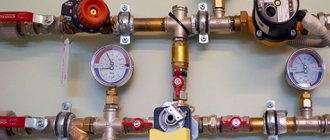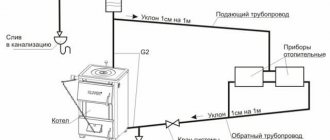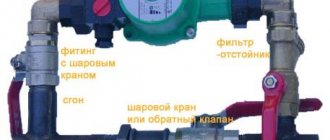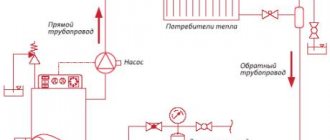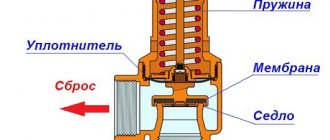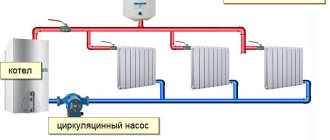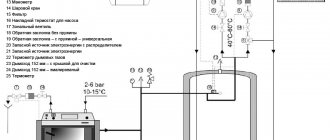Home / Gas boilers
Back
Published: 05/14/2019
Reading time: 3 min
0
16158
As a result of an increase in pressure on the boiler above the nominal value, periodic blocking occurs, and excess coolant is released from the safety valve.
The heating system is not designed to operate in a mode where all its components are under excessive load. Overloads can lead to negative consequences due to the failure of expensive elements.
Therefore, the reason why pressure increases in a double-circuit boiler must be eliminated immediately. For users of an autonomous heating system, a list of probable malfunctions that can lead to increased pressure and ways to eliminate them is presented.
- 1 Why you need to monitor the pressure in the boiler
- 2 Reasons for increased pressure in case of boiler damage
- 3 Why does the pressure rise in the heating boiler 3.1 Air lock in the system
- 3.2 Malfunctions of the expansion tank
- 3.3 Other causes of increased pressure
Why do you need to monitor the pressure in the boiler?
Safety group
The operation of the boiler is accompanied by changes in pressure in the circuit, which must be kept within established limits. This means that when the boiler is turned on, the pressure gauge must show a minimum bar value, and during operation the pressure cannot exceed the permissible level. Thus, three types of pressure are defined:
- dynamic pressure is the magnitude of the coolant voltage circulating in the heating circuit;
- static pressure - measured at idle and determines the load exerted by the coolant on the heating circuit;
- maximum pressure is the permissible load limit at which normal operation of the system is allowed.
If the pressure in the gas boiler increases, the consequence is that the normal operation of the system ceases; water is periodically released through the relief valve or from the expansion tank.
Pressure in the expansion tank of the Baxi boiler
One of the most popular models in the Baxi line is the Baxi Eco Four 24 gas boiler. The equipment can be with a closed or open combustion chamber. The power of the unit is 24 kW. The name indicates the letter “F” if the gas boiler has a closed combustion chamber and forced smoke removal. In apartments, turbocharged boilers from Baxi are most often used. Let's look at the design of the expansion tank, breakdowns, pressure drop and how to fill the Baxi expansion tank with air.
Reasons for increased pressure in case of boiler damage
It is difficult for a person who does not have experience in servicing heating systems to independently determine the true reason why the pressure in the heating boiler rises. However, to give you an idea of possible malfunctions, a list of probable causes is provided.
- Increasing pressure up to 1 atm. may occur as a result of depressurization of the heat exchanger. Such consequences result from the formation of cracks in the housing during prolonged operation. The appearance of cracks may be the result of a manufacturing defect or poor strength of the material, the consequences of a water hammer or equipment wear. In this case, the coolant volume systematically begins to replenish. However, it is not possible to visually determine the location of the leak due to the instantaneous evaporation of the liquid when the burner is running. This malfunction leads to replacement of the heat exchanger.
- An increase in pressure can occur when the make-up valve is open. The weak pressure inside the boiler contrasts with the increased pressure in the pipeline. This causes additional water to flow through the open valve. Thus, the water pressure will gradually increase until it is released. If the pressure in the pipeline decreases, the water supply to the boiler is shut off by the coolant, reducing the pressure in the circuit. The make-up valve must be kept closed, and if it is broken, replaced.
- An increase in pressure may occur due to a malfunction of the three-way valve. Such a breakdown leads to water entering the circuit from the expansion tank. Debris periodically collects on the valve, which can cause it to break. This element must be cleaned periodically and, if faulty, replaced. To prevent contaminants from entering the water supply, you can install a simple corner filter.
- If all signs indicate that the pressure in the circuit is increasing, and the pressure gauge needle does not respond, this means that it has failed. A broken device makes it impossible to control the operation of the system and needs to be replaced.
Excessive pressure in the heating circuit is determined by the readings of the pressure gauge; if the indicator exceeds the permissible level, measures must be taken immediately. In addition to the pressure gauge, an excess of the permissible norm can be indicated by a safety valve, from which water will begin to flow if the pressure has risen.
Control methods
One of the control methods is a pressure gauge for measuring pressure in the heating system. This device must be mounted at the following points:
- at the inlet and outlet of the boiler (in many units produced today, pressure gauges are included);
- at the lowest and highest points of the system (in multi-storey buildings);
- in places of divergence: after tees, in manifolds, after two and three-way valves.
Thanks to pressure gauges, pressure can be monitored visually. If suddenly the indicators reach critical numbers, then the pressure needs to be relieved; safety valves are provided for this. Such a device should be installed in the supply pipeline immediately after the boiler, since when the working medium boils in the heat exchanger, it is through it that it will be discharged.
The safety valve, pressure gauge and air vent are included in the safety group of boiler equipment. In addition, membrane expansion tanks are also equipped with relief valves.
The design includes not only relief valves, but also bypass valves. They are mounted on a bypass, through which the coolant is directed around the circuit. If a blockage or air lock appears in the circuit, which contributes to the occurrence of increased pressure, then at this moment the bypass valve is activated. The circulation pump will immediately begin pumping coolant through a small circuit: “boiler - bypass - pump - boiler”. If such a safety system is not in the boiler, then due to too much load the pump will very quickly stop functioning.
In order for the coolant pressure in the system to be optimal and not exceed the norm, it is important to control the pressure in the air chamber of the expansion tank. Typically, the indicator is 1.5 Atm. If the value is below the set value, the membrane will simply rupture; if it is exceeded, the coolant pressure will also increase.
In order to check the tightness of the equipment, you need to perform an event called pressure testing.
Why does the pressure rise in the heating boiler?
Filling the heating circuit is carried out subject to the exact sequence of actions; deviation from the rules leads to malfunctions of the system. When starting the system seasonally, it is necessary to adjust the adjustable auxiliary elements and fix the position of the valves in the correct position.
Air lock in the system
Thermal imager shows a plug
If the heating system malfunctions, expressed in an arbitrary increase in pressure, the temperature of the coolant sometimes drops and the boiler blocks. As a consequence, in such situations, an imbalance occurs in the functioning of the system, leading to the failure of expensive elements.
Airing of the circuit can lead to similar consequences, and the resulting plugs are recognized as a common reason why the pressure in the boiler increases.
Air locks can occur for a number of reasons:
- equipment malfunction;
- the system was launched with violations;
- automation failure;
- formation of cracks in the heat exchanger housing.
The above consequences are the result of neglecting the established rules for operating the heating system.
The following actions can lead to these breakdowns:
- the DHW circuit is filled from the top point;
- upon startup, the system is rapidly filled with water;
- before launch, the check required for the air vents, as well as each Mayevsky valve, was not carried out;
- air was not bled from the radiators after repair;
- The vibrating impeller with which the circulation pump is equipped slowly pumps air, causing a circulation problem.
Such problems are eliminated by relieving pressure from the heating circuit. Next, the circuit is filled with water, carried out from the bottom point. It is important to consider that while filling the system, it is necessary to keep the air bleed valves open. Filling is done gradually without undue haste, and the end of the process is signaled by the appearance of water at the top point of the system.
Expansion tank malfunctions
The expansion tank can look like a separate wall element or as part of the boiler. It is designed to collect excess coolant from the heating circuit. When water in the system is heated, its volume can increase by up to 4%, and the expansion tank is designed to compensate for this difference.
Incorrect calculation of the system volume may lead to the installation of a tank with a smaller capacity than necessary for compensation. In this case, all the excess water cannot leave the system and this becomes the explanation why the pressure increases. The dimensions of the tank are also affected by the power of the installed boiler.
When choosing a Navien gas unit, you should install a tank whose volume is 10% of the total displacement of the system, and if solid fuel equipment is installed, this figure doubles.
A hidden breakdown is considered to be a rupture of the membrane in the expansion tank. Such damage may not be noticed immediately, but in the meantime, unfixed coolant can fill the entire internal cavity. The pressure in the circuit will decrease, but if, in this situation, the system is recharged, this will lead to an arbitrary increase in pressure.
Other causes of high blood pressure
Other malfunctions also come into view, which may explain why the pressure in the heating system increases. If you do not regularly check the pressure readings in the system, then inconspicuous problems can cause expensive repairs.
- If the fittings are blocked, then at the time of intake the pressure will increase, and the control sensors will block the equipment. To avoid consequences caused by this reason, during startup it is necessary to inspect the valves and taps to ensure that the valves are in good condition.
- Dirt and rust that gradually accumulate in the system can clog the mesh filter. Therefore, you should either clean this element regularly, and if washing the filters does not help, then you should install a washable or magnetic filter. With the correct design of such elements, the pressure does not rise above the permissible level.
- A controller or thermostat can fail, and problems with automation lead to negative consequences. The cause may be either premature wear or a manufacturing defect. In addition, a malfunction of these elements can be caused by an incorrect connection.
Such problems can be identified in a timely manner only if the readings of control devices are systematically monitored. They are not capable of dramatically disrupting the operation of the system, but are capable of gradually changing the indicators, leading to the critical point at which the boiler operates under load.
General information
Many users often ask the question: what pressure should be in the heating system in a private home? In order to answer this, you first need to determine the variations in pressure.
There are different types of pressure in the heating system:
- Dynamic pressure. Here the circulation pump acts as the main source of value: it starts working and pressure is generated.
- Static coolant pressure. The value of this indicator depends on the height of the coolant column in a stationary position, and the force with which it acts on the links of the heating devices. When making calculations, do not forget that a height of 10 meters forms one atmosphere.
- The operating pressure in the heating system is a combination of the values of the other two types described above. By observing this parameter, you will be confident in the uninterrupted, and most importantly, safe operation of the heating device.
The water jacket of the boiler, which is located on the lower level, is most loaded. If in a private house, the boiler room is located on the roof, then the strongest pressure occurs on the pipeline network at the very bottom.
Depending on how the coolant heats up when it is stationary, the water pressure in the system increases due to the fact that the amount of liquid itself increases. High performance is achieved when the circulation pump operates at the moment of formation of dynamic pressure, which is necessary for the movement of the coolant along the circuit.
In order to objectively assess the situation, it is necessary to measure the pressure force in the lowest section of the circuit. Therefore, when you are first designing a system, be sure to indicate at this point the need to install pressure gauges.
Why does the pressure in the boiler drop?
The most common consequence of malfunctioning heating systems is a loss of pressure in the circuit. There are a number of common reasons why the pressure gauge will show a drop in pressure:
- violation of the functionality of the expansion tank;
- power outages;
- a leak formed in the heating circuit;
- incorrect calculations when choosing a boiler for a given room.
When the pressure in the boiler decreases, water stops flowing. If the gas pressure decreases, the automation will stop the boiler. To prevent breakdowns that occur every time at unexpected times, first of all, it is necessary to systematically monitor the operation of the system.
At the end of the heating season, you should regularly carry out diagnostics and, if necessary, repair the equipment, this will allow you to keep the pressure not lower than the minimum level.
Pressure in closed heating systems
With the help of a circulation pump, dynamic pressure is created in the heating system.
Thanks to this, a closed system has the following advantages:
- the length of the heating circuit increases in direct proportion to the pump power;
- batteries can be connected both in series and in parallel; with a parallel connection, the heat is distributed more evenly;
- possibility of installing small diameter pipes;
- gas savings, since the coolant has a higher speed than in open systems, it does not cool down as much;
- to relieve excess pressure, you can reduce the power of the circulation pump;
- the ability to select pump power to overcome hydraulic pressure and depending on the length of the circuit and the diameter of the pipes.
